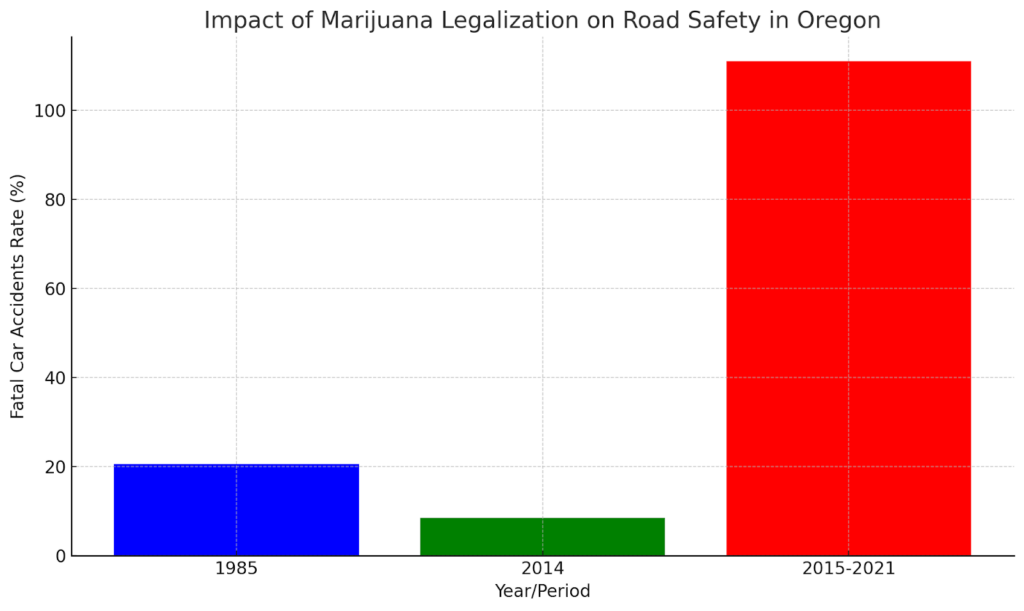Intoxicated drivers on Oregon roads have been a concern for local police since the 1980s. Just so you can get an idea of how bad the situation is, 30% of all deadly vehicle crashes that have occurred in the state have been the result of alcohol consumption, according to the National Highway Traffic Safety Administration (NHTSA).
Sure enough, the Oregon government was very worried about the potential increase in the number of accidents after the legalization of weed. Unfortunately for Colorado, drug-driving statistics have skyrocketed, with 36% of car occupants killed in crashes testing positive for marijuana use.
However, Oregon didn’t follow the same trend, at least not at the beginning. In fact, just the opposite happened. When marijuana was first legalized, people became more reluctant to get drunk, resulting in a significant reduction in alcohol-related fatalities in the state. What’s more, the overall number of fatalities dropped big time.
The results of the study conducted by Columbia University’s Mailman School of Public Health were a surprise for everyone. After analyzing the statistics on car accidents from 1985 to 2014, the researchers found that the legalization of marijuana in Oregon actually correlated with a decrease in fatal car accidents, in particular among drivers aged between 25-44.
Compared to a whopping 20.6% fatality rate in 1985, in 2014, it was only 8.5, which indicated a positive change in road safety, ironically thanks to the legalization of weed.
It’s worth noting that now the situation in Oregon isn’t as positive as it was in 2014. According to Oregon Public Broadcasting, in 2015, 16 people were killed in cannabis-related vehicle accidents, and in the next few years, as Roffman reports, that number increased up to 111%, calling for renewed attention and action. Though, in fairness, even that increase isn’t huge.
All this shows that Oregon’s fears about legal access to cannabis have not materialized, and people who have switched to smoking instead of drinking, as a rule, do not get behind the wheel.
Even so, Oregon State Police stay on guard for road safety. They were among the first who, in 1995, started a dedicated Drug Recognition Expert (DRE) course tailored to training officers to detect signs of drug impairment, including marijuana, in drivers. Now, this course is available to all officers throughout the country.
Since then, more than 200 police officers have successfully completed the course and have been strategically deployed across the state to effectively combat drug-impaired driving.
And their efforts have paid off remarkably. A report from MJM Law Office highlights the impact they’ve made. In Oregon alone, there have been over 20,000 arrests related to DUI, with a notable 10% of those cases involving drug use.
Interestingly, while people, in general, seem to be more conscious when it comes to smoking weed and driving, Oregon’s drug overdose death rate is nonetheless quite high. Although you won’t find Oregon in the unfortunate top ten, a score of 26.8 still doesn’t speak in favor of marijuana legalization.

Here is the graph visualizing the impact of marijuana legalization on road safety in Oregon.
Final Words
To sum things up, the statistics on drug driving in Oregon tell us a unique story. Legal access to marijuana not only did not lead to an increase in DUI accidents, as the state authorities anticipated but actually led to a decrease in fatalities while intoxicated.
Although the number of cannabis-related vehicle accidents has slightly increased since 2014, the government has taken the necessary measures to bring the situation under control. Oregon was one of the first states to introduce the DRE course, which has made a significant contribution to the fight against impaired driving.